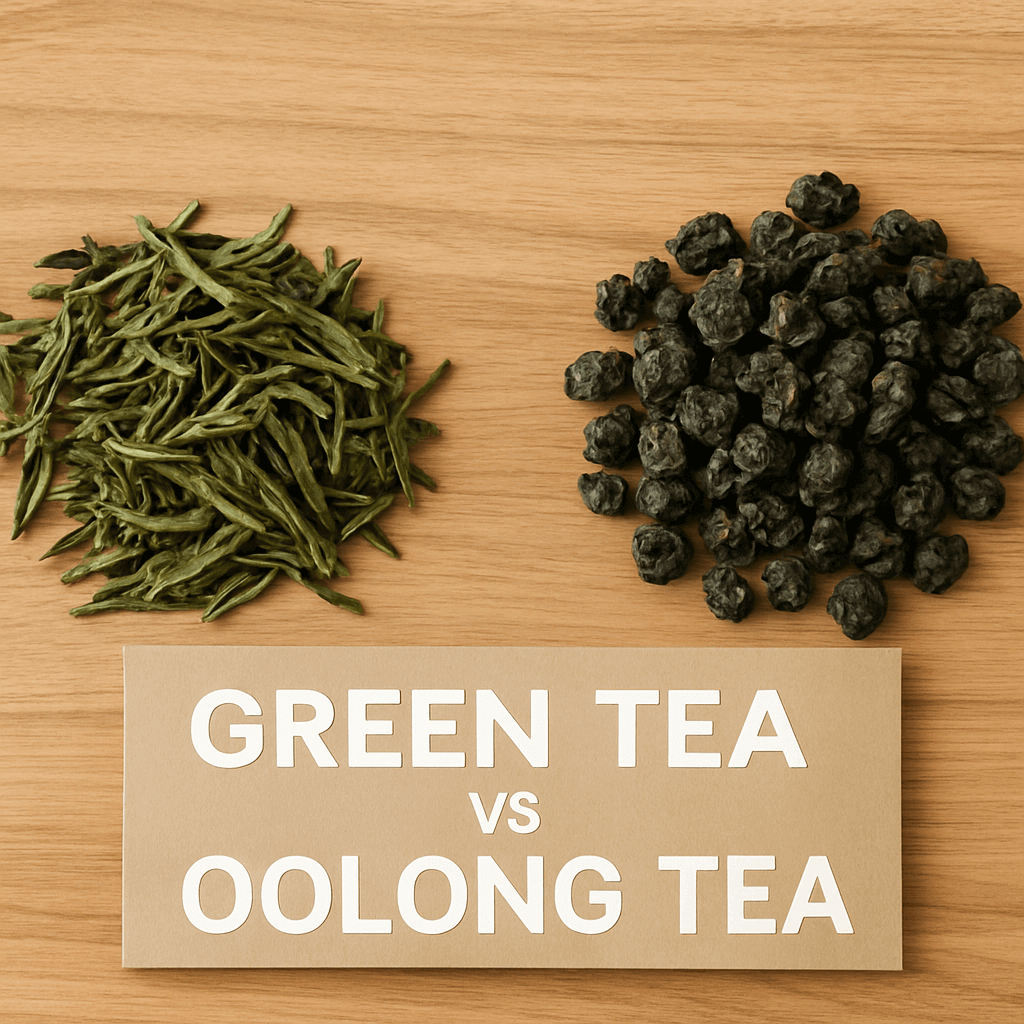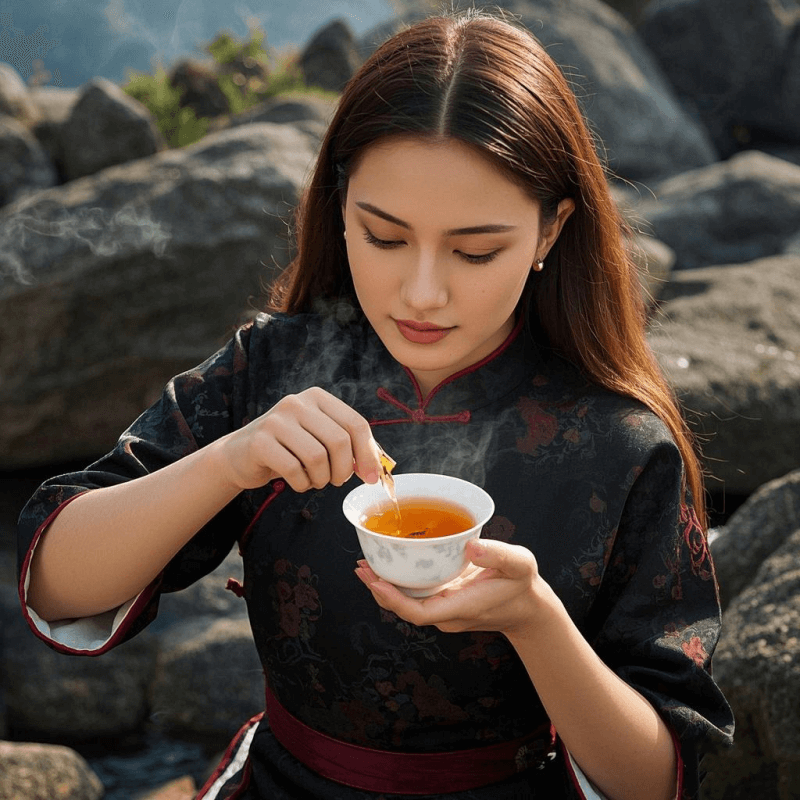1. Introduction: Why the Question “Is Oolong a Green Tea?” Matters

Walk into any tea shop, and you’ll likely see shelves lined with green, black, and oolong teas—yet confusion lingers: is oolong a green tea? This question isn’t just academic; it shapes how we brew, enjoy, and even benefit from these teas. For beginners, misclassifying oolong as green tea can lead to over-steeping (resulting in bitterness) or missing out on its unique flavor profile. For enthusiasts, understanding the distinction deepens appreciation for tea’s cultural and scientific complexity.
A 2023 survey by the Tea Association of the U.S.A. found that 42% of consumers struggle to differentiate oolong from green tea, often assuming they’re variations of the same leaf. This confusion isn’t surprising: both teas originate from the Camellia sinensis plant, and their leaves can look similar in dry form—twisted, vibrant, and fragrant. Yet, as any tea master will tell you, the difference lies in what happens after the leaves are plucked.
Consider this: a novice brewing oolong like green tea might use 170°F water and steep for 2 minutes, resulting in a flat, underwhelming cup. A seasoned drinker, knowing oolong’s tolerance for higher heat, would use 195°F water and steep for 3–4 minutes, unlocking its rich, layered flavors. This is why answering “is oolong a green tea” isn’t just about classification—it’s about maximizing your tea-drinking experience.
2. What Is Oolong Tea? Origins and Processing Explained
Is Oolong a Green Tea???
Oolong tea—a staple of Chinese and Taiwanese tea culture—occupies a unique spot in the tea family, defined by its processing:
🌱 Origins: A Tale of Two Regions
- China’s Fujian Province: The birthplace of oolong, where legends trace its creation to the Ming Dynasty. Wuyi Mountain oolongs (e.g., Da Hong Pao) are grown in rocky, mineral-dense soil, absorbing earthy notes that make each sip taste like a walk through misty cliffs. Farmers here still use traditional “rock storage” to age select batches, enhancing their depth over years.
- Taiwan: Introduced in the 19th century, Taiwanese oolongs (e.g., Alishan, Dongding) thrive at high altitudes. Cool mountain air slows growth, allowing leaves to accumulate more amino acids and aromatic compounds. The result? Teas with bright floral notes, often described as “buttery” or “honeyed.”
👩🍳 Processing: The Art of Controlled Oxidation
Unlike green tea’s “stop-oxidation-early” approach, oolong tea thrives on intentional oxidation (10–80%):
- Plucking: Harvesters select leaves in the “two leaves and a bud” format, ensuring optimal nutrient density. Timing matters—spring harvests (March–April) yield more delicate flavors, while autumn (September–October) brings richer, more robust profiles.
- Withering: Leaves are spread on bamboo trays, exposed to sun or warm air for 4–6 hours. This reduces moisture by 30%, activating polyphenol oxidase—an enzyme critical for oxidation. Master tea makers check leaves hourly, feeling for a slight wilting to know when they’re ready.
- Oxidation: The most labor-intensive step. Leaves are gently rolled in bamboo baskets (“yao qing”) to bruise cell walls, releasing enzymes that react with oxygen. For light oolongs (e.g., Tie Guan Yin), this process stops after 2–3 hours, preserving floral notes. For dark oolongs (e.g., Da Hong Pao), oxidation continues for 6–8 hours, developing roasted, nutty flavors.
- Fixing (Sha Qing): Pan-frying over low heat (150–180°F) denatures enzymes, halting oxidation. This step is done by hand in traditional farms, with tea makers using bamboo shovels to toss leaves evenly—too much heat, and the tea becomes charred; too little, and oxidation resumes.
- Rolling & Drying: Leaves are shaped into tight curls (to lock in aroma) or loose twists (for faster brewing). They’re then air-dried until moisture drops to 5–7%, ensuring shelf stability without losing flavor.
This meticulous process explains why oolong tea tastes worlds apart from green tea—and why it’s revered as a “living craft” in tea culture.
3. Comparing Oolong Tea and Green Tea: Key Differences

Is Oolong a Green Tea:
To answer “is oolong a green tea,” let’s break down their core distinctions with granular detail:
| Aspect | Oolong Tea | Green Tea |
| Oxidation Level | 10–80% (varies by style):- Light: 10–30% (Tie Guan Yin)- Medium: 30–60% (Dongding)- Dark: 60–80% (Da Hong Pao) | 0–5% (minimal):- Steamed (Japanese): 1–2%- Pan-fried (Chinese): 3–5% |
| Color | Dry leaves: Deep green to brown-blackSteeped: Golden-amber (light) to reddish-brown (dark) | Dry leaves: Bright green to oliveSteeped: Pale yellow-green (steamed) to amber (pan-fried) |
| Flavor Profile | – Light: Jasmine, peach, green apple- Medium: Honey, cream, almond- Dark: Roasted chestnut, caramel, mineral | – Steamed: Grass, seaweed, fresh spinach- Pan-fried: Toasted rice, walnut, buttery vegetal |
| Caffeine Content | 30–50mg/cup (varies by infusion):- 1st steep: 50mg- 3rd steep: 30mg | 20–45mg/cup:- Sencha: 30–35mg- Matcha: 35–45mg (due to whole leaf consumption) |
| Key Compounds | – Theaflavins: 8–12mg/g (supports metabolism)- Catechins: 15–20mg/g (antioxidant)- L-theanine: 1.5–2% (promotes calm) | – EGCG: 25–35mg/g (potent antioxidant)- Catechins: 30–40mg/g- L-theanine: 1–1.5% |
| Brewing Temperature | – Light: 185°F (85°C)- Dark: 205°F (96°C)- Steep time: 30s–5min (multiple infusions) | – Steamed: 160°F (70°C)- Pan-fried: 175°F (79°C)- Steep time: 1–2min (single infusion) |
The critical takeaway? Oxidation isn’t just a technicality—it’s a flavor transformer. Green tea’s minimal oxidation locks in fresh, vegetal notes, while oolong tea’s partial oxidation creates a spectrum of tastes no green tea can replicate.
4. Is Oolong a Green Tea? Scientific and Cultural Perspectives
🔬 Scientific Classification
Botanically, all true teas (green, oolong, black) share the Camellia sinensis plant, but that’s where similarities end. The International Tea Committee classifies teas by processing, not species, defining oolong as “partially oxidized” and green tea as “non-oxidized.”
Why does this matter? Oxidation alters tea’s chemical structure:
- Green tea retains 60–80% of its original catechins (e.g., EGCG), powerful antioxidants linked to cell protection.
- Oolong tea’s oxidation converts 30–50% of catechins into theaflavins and thearubigins, compounds with unique anti-inflammatory properties.
A 2022 study in Food Chemistry confirmed these differences, finding oolong’s polyphenol profile overlaps with neither green nor black tea—solidifying its status as a distinct category.
🏯 Cultural Context
In China’s 2,000-year tea tradition, “cha” (tea) is divided into six categories, each with sacred rituals:
- Green tea: Associated with purity, served at weddings and ancestral ceremonies.
- Oolong tea: Celebrated in gongfu cha, a meditative practice where each steep is savored as a moment of mindfulness.
Taiwanese tea culture takes this further—oolong is often served during business meetings as a symbol of balance and respect, while green tea is reserved for casual, daily sipping. To call oolong a green tea in these contexts would dismiss centuries of cultural nuance.
5. Benefits of Oolong Tea vs. Green Tea
Both teas offer wellness perks, but their unique profiles cater to different needs:
🌟 Oolong Tea Benefits
- Metabolic Support: A 2011 study in The American Journal of Clinical Nutrition tracked 102 participants who drank 3 cups of oolong daily for 6 weeks. They showed a 12% increase in fat oxidation during exercise, attributed to theaflavins boosting lipolysis (fat breakdown).
- Steady Energy: Its 30–50mg caffeine (paired with L-theanine) creates a “calm alertness” effect. A 2016 study in Nutrients found oolong drinkers reported 23% less afternoon fatigue than coffee drinkers, making it ideal for 2–3 PM slumps.
- Gut Health: Polyphenols in oolong feed beneficial gut bacteria like Lactobacillus, increasing short-chain fatty acid production by 22% (per 2023 research in Gut Microbes). This supports digestive regularity and immune function.
🌟 Green Tea Benefits
- Antioxidant Powerhouse: EGCG in green tea is 10x more potent than vitamin C at neutralizing free radicals (per Mayo Clinic). This may lower risk of chronic diseases like heart disease and type 2 diabetes.
- Gentle Caffeine: With 20–45mg per cup, it’s perfect for sensitive stomachs or evening sipping (avoiding the jitters of coffee).
- Hydration with Benefits: Unlike sugary drinks, green tea hydrates while delivering antioxidants—a win for those prioritizing daily fluid intake.
6. How to Choose Between Oolong and Green Tea for Your Lifestyle
Your choice depends on taste, routine, and goals:
☕ Choose Oolong Tea If…
- You crave flavor evolution: Light oolongs (e.g., Alishan) start floral, then develop buttery notes over 5+ infusions—ideal for slow afternoons.
- You need sustained focus: The L-theanine-caffeine combo in oolong provides 3–4 hours of steady energy, great for work or study marathons.
- You enjoy ritual: Brewing oolong with a gaiwan (lidded cup) turns tea time into a mindful practice, reducing stress. Try Browse our premium teaware for brewing the perfect oolong cup to elevate the experience.
🌿 Choose Green Tea If…
- You prefer bright, crisp flavors: Steamed sencha’s grassy notes pair beautifully with sushi or light salads, cleansing the palate.
- Antioxidants are your priority: Adding matcha to smoothies or oatmeal boosts daily polyphenol intake without extra calories.
- You’re short on time: Green tea’s single steep (1–2 minutes) fits into busy mornings—no fuss, just quick refreshment.
Pro Tip: For tea lovers who can’t choose, rotate by season: light oolong in spring, green tea in summer, dark oolong in fall, and aged oolong in winter.
7. Conclusion: Understanding Where Oolong Stands Among Teas
The answer to “is oolong a green tea” is definitive: no. Oolong is a distinct category, a bridge between green tea’s freshness and black tea’s depth, defined by intentional oxidation and centuries of craftsmanship. Its diversity—from floral Taiwanese blends to roasted Fujian classics—makes it a tea for every palate and moment.
Whether you’re sipping it in a gongfu ceremony or steeping a quick cup, oolong tea invites exploration. Find your ideal oolong tea based on flavor and origin to discover why it’s cherished as one of tea’s greatest treasures.
In the end, tea’s beauty lies in its variety. Green tea excels in bright simplicity, but oolong? It’s a masterpiece of complexity—proof that the best things in life come from balancing precision and patience.
Wondering is oolong a green tea? Dive into key differences between oolong tea and green tea—oxidation, flavor, benefits. Science-backed insights to clarify your choice—click here!
